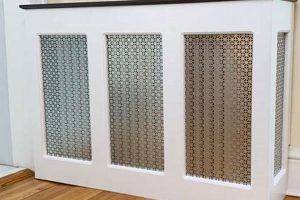Creation of individualized carrying solutions through crafting is a popular activity. These customized fabric containers serve a multitude of purposes, ranging from grocery shopping to personal accessory. The process generally involves selecting fabric, cutting patterns, and sewing the components together to form a functional bag.
Constructing personalized bags offers several advantages, including cost savings compared to purchasing retail bags and the opportunity for unique aesthetic expression. Historically, crafting reusable carrying solutions has been a method of resourcefulness, reducing reliance on disposable options and promoting sustainable practices. This practice allows for a high degree of personalization and creative output.
The subsequent sections will delve into specific techniques for constructing these items, including material selection, design considerations, and step-by-step sewing instructions, providing a thorough guide for creating custom carrying solutions.
Crafting Personalized Fabric Carriers
The following constitutes practical advice for achieving optimal results when constructing customized carrying solutions.
Tip 1: Fabric Selection is Paramount: Choose durable, washable materials suitable for the intended use. Consider canvas, denim, or cotton blends for increased longevity. Prior to cutting, pre-wash the fabric to mitigate shrinkage.
Tip 2: Precise Pattern Cutting Ensures Accuracy: Utilize sharp scissors or a rotary cutter in conjunction with a cutting mat and ruler. Accuracy during this phase is crucial for the final product’s symmetry and structural integrity.
Tip 3: Reinforce Stress Points for Durability: Strengthen areas such as handles and the bottom corners with additional stitching or interfacing. This preventative measure extends the bag’s lifespan under heavy loads.
Tip 4: Seam Allowance Consistency is Critical: Maintain a uniform seam allowance throughout the construction process. This practice contributes to a professional finish and accurate dimensions.
Tip 5: Invest in Quality Sewing Equipment: A reliable sewing machine, sharp needles, and durable thread significantly impact the ease and quality of the project. Select needle size and thread weight appropriate for the fabric type.
Tip 6: Consider Lining for Added Structure and Finish: Incorporating a lining enhances the bag’s internal appearance and provides additional protection for its contents. Lining materials can be selected to complement or contrast with the exterior fabric.
Tip 7: Experiment with Embellishments Responsibly: Personalization can be achieved through various techniques, including embroidery, appliqu, and fabric paint. Ensure embellishments are securely attached and do not compromise the bag’s structural integrity.
Adhering to these guidelines promotes a more satisfying and successful creation experience, resulting in a robust and aesthetically pleasing final product.
The subsequent section will address common challenges encountered during this process and provide solutions to ensure a smooth crafting endeavor.
1. Material Durability
Material durability is a cornerstone consideration when constructing personalized fabric carriers. The longevity and functionality of the finished product are directly correlated with the chosen material’s resistance to wear and tear. This is especially important for items intended for regular use, such as grocery or book bags.
- Tensile Strength
Tensile strength refers to a material’s ability to withstand pulling forces without breaking. In the context of constructing carrying solutions, a fabric with high tensile strength is essential for supporting heavy loads. For example, canvas or denim generally exhibit higher tensile strength compared to lighter cotton fabrics, making them more suitable for carrying substantial weight. Low tensile strength can lead to ripping and premature failure of the bag.
- Abrasion Resistance
Abrasion resistance describes a material’s capacity to withstand surface wear from rubbing or friction. Bags used frequently are subject to abrasion, whether from being dragged across surfaces or rubbing against the wearer’s body. Durable materials like waxed canvas or tightly woven synthetic blends offer superior abrasion resistance, preventing the fabric from thinning or developing holes over time. The selection impacts the bag’s aesthetic appeal and structural integrity.
- Tear Resistance
Tear resistance is the measure of a material’s ability to resist tearing when subjected to a concentrated force. Tears can initiate at stress points, such as corners or around handles, and propagate rapidly if the fabric lacks adequate tear resistance. Ripstop nylon or canvas fabrics with reinforced weaves provide enhanced tear resistance, mitigating the risk of damage from accidental snags or punctures. Selection of suitable tear resistant materials greatly improves product life.
- Colorfastness
Colorfastness denotes a material’s ability to retain its original color when exposed to environmental factors such as sunlight, washing, and perspiration. Fabrics lacking colorfastness may fade or bleed, detracting from the bag’s appearance and potentially staining other items. Solution-dyed fabrics or materials treated with color-fixatives offer superior colorfastness, ensuring that the bag maintains its vibrant appearance over extended use. This is particularly relevant if the intended design incorporates bold colors or intricate patterns.
The interplay of these durability facets directly influences the overall value and utility of the constructed bag. Selecting appropriate materials is therefore crucial for ensuring that the project yields a functional and aesthetically pleasing item capable of withstanding the demands of regular use. Furthermore, understanding material properties enables more informed design choices and tailoring of the project to its intended purpose.
2. Seam Integrity
Seam integrity directly impacts the longevity and utility of crafted fabric carriers. Deficient seams compromise the bag’s structural stability, leading to premature failure, rendering it unsuitable for its intended purpose. Seam failure stems from inadequate sewing techniques, use of inappropriate thread, or selection of weak fabric. A poorly constructed seam under stress may unravel, causing the bag to tear, especially when carrying heavy items. For example, a tote bag used for groceries with compromised seams may split open during transport, resulting in spillage and product loss. This illustrates the cause-and-effect relationship between seam quality and bag functionality.
Effective seam construction necessitates careful attention to several factors. Selecting a thread type appropriate for the chosen fabric is crucial. Heavy-duty threads, su
ch as those made of polyester or nylon, offer greater resistance to abrasion and tension compared to cotton threads. Maintaining a consistent seam allowance is also vital for even stress distribution along the seam line. Backstitching at the beginning and end of each seam secures the stitches, preventing unraveling. In high-stress areas, such as the attachment points for handles, reinforcing the seams with multiple rows of stitching is a recommended practice. Example: Reinforcing the seam in the bottom of tote bags, as this carries most of the weight.
In conclusion, seam integrity is not merely an aesthetic consideration; it is a fundamental requirement for a functional and durable bag. Paying close attention to thread selection, sewing technique, and reinforcement strategies directly contributes to the bag’s capacity to withstand regular use and heavy loads. Neglecting seam integrity ultimately diminishes the value and lifespan of the crafted carrying solution. Therefore, incorporating durability, material strength, and proper seam construction is a holistic approach when considering the construction of a fabric bag.
3. Handle Strength
The correlation between handle strength and the functionality of crafted fabric carriers is critical. The bag handles serve as the primary point of contact for carrying and supporting the bag’s contents. Therefore, handle failure directly results in the bag becoming unusable, potentially causing damage to the carried items. Understanding the causes of handle weakness and applying appropriate construction techniques are paramount to creating durable and reliable carrying solutions.
Several factors contribute to handle strength. Material selection is a primary consideration; durable fabrics like canvas, webbing, or reinforced cotton are preferable over lighter, less robust materials. The method of attachment is also significant. Handles that are merely sewn onto the bag body are more prone to failure than handles that are integrated into the bag’s structure, extending down the sides or wrapping around the bottom. Reinforcing the attachment points with multiple rows of stitching or adding metal rivets further enhances handle strength. For example, a handcrafted grocery bag with handles constructed from lightweight cotton webbing and a single row of stitching would likely fail under the weight of several heavy items, whereas a bag with handles made from reinforced canvas and multiple rows of stitching could withstand significantly more weight. A poorly attached handle leads to bag failure.
In conclusion, handle strength is an indispensable element in the construction of durable fabric carriers. Careful attention to material selection, attachment method, and reinforcement techniques directly translates to a more reliable and functional bag. Neglecting handle strength undermines the value of the project, rendering the finished product unsuitable for its intended purpose. The practical significance of understanding and implementing robust handle construction techniques lies in creating a carrying solution that can withstand the demands of regular use, providing a reliable and sustainable alternative to disposable bags. From a simple tote bag to a heavy book bag, handle strength is essential and a worthwhile consideration for increasing the lifespan and value of your product.
4. Size Versatility
Size versatility is a critical attribute within the realm of crafting individualized fabric carriers. The dimensions of the constructed item directly dictate its utility and suitability for a range of purposes. A bag designed to accommodate oversized items, such as artwork or large books, would be impractical for carrying smaller essentials, such as wallets or phones. Conversely, a small pouch would be insufficient for grocery shopping or transporting larger items. The intended purpose of the finished product dictates the dimensions required, leading to a direct correlation between size selection and functionality. The dimensions must support the intended usage of the bag. As an example, a crafter might create a large, reinforced bag for carrying quilting supplies, including fabric bolts and cutting mats, while simultaneously constructing smaller, drawstring bags for organizing notions and threads.
The ability to customize the size of these crafted containers offers distinct advantages compared to purchasing pre-made bags. Standard retail bags often adhere to limited size ranges, potentially failing to meet specific needs. By contrast, constructing one’s own bags allows for precise tailoring to desired dimensions, ensuring optimal functionality. This is particularly relevant for individuals with specialized requirements, such as artists needing custom portfolios or musicians requiring bags to fit specific instruments. Furthermore, size versatility extends to the design process, enabling the incorporation of compartments, pockets, and dividers to further enhance organization and accessibility. One might design a custom bag with interior pockets for tools, while also creating a separate compartment for carrying sensitive electronics.
In conclusion, size versatility is an indispensable element in constructing individualized fabric carriers. The ability to customize dimensions to meet specific needs directly enhances the utility and functionality of the finished product. This adaptability allows for the creation of carrying solutions that precisely match individual requirements, offering a significant advantage over relying solely on commercially available options. By understanding and embracing size versatility, individuals can create bags that are not only functional and durable but also perfectly suited to their unique lifestyles and professional demands. The choice of size should be paramount to its use.
5. Design Complexity
Design complexity, in the context of crafting customized fabric carriers, manifests as a spectrum ranging from minimalist, single-piece constructions to elaborate multi-panel creations incorporating intricate embellishments and specialized features. The degree of design complexity directly influences the time investment, skill level required, and material consumption associated with the project. Increased complexity correlates with an increased risk of errors during the construction process, demanding greater precision in pattern cutting, sewing, and finishing. For instance, a simple rectangular tote bag requiring only straight seams represents a low level of design complexity, while a bag featuring curved panels, zippered pockets, and quilted details embodies a significantly higher level.
The choice of design complexity should be informed by several factors, including the intended use of the bag, the available resources, and the maker’s skill set. A beginner might opt for a simpler design to master fundamental sewing techniques, while an experienced crafter could undertake a more challenging project to showcase their expertise. Incorporating design elements such as linings, internal pockets, or adjustable straps introduces additional layers of complexity, but enhances the bag’s functionality and aesthetic appeal. The strategic placement of reinforcement panels or decorative stitching can improve the bag’s durability and visual interest, albeit at the cost of increased construction time
and effort. The design should match the user’s needs, and reflect the level of craftsmanship of the creator.
In summary, design complexity is a critical consideration in the creation of customized fabric carriers. Striking a balance between aesthetic aspirations, practical requirements, and available resources is essential for achieving a successful and satisfying outcome. Overly ambitious designs may lead to frustration and project abandonment, while overly simplistic designs may fail to meet the intended functional needs. Understanding the implications of design complexity empowers creators to make informed decisions, resulting in bags that are both visually appealing and functionally sound. When construction a “diy tote bag”, it is important to plan accordingly.
6. Cost Efficiency
Cost efficiency is a primary driver for individuals undertaking the creation of personalized fabric carriers. The financial implications of constructing such items, as opposed to purchasing commercially available alternatives, warrant thorough consideration. The potential for cost savings must be weighed against the investment of time and resources required for successful project completion. Considerations include material selection and construction investment.
- Material Acquisition Strategies
The method of acquiring materials significantly influences overall project cost. Utilizing repurposed fabrics, such as discarded clothing or linens, minimizes expenditure. Sourcing materials from discount retailers or during sales events presents another avenue for cost reduction. Conversely, selecting premium-quality or specialized fabrics may negate potential savings. The type of material one choose should align with the budget.
- Equipment and Tooling Costs
Construction of fabric carriers necessitates access to basic sewing equipment, including a sewing machine, scissors, measuring tools, and thread. Individuals lacking these tools must factor in the expense of acquisition. While initial investment in quality equipment may prove substantial, it offers long-term cost benefits compared to relying on infrequent or professional sewing services. The availability and quality of sewing tools affects the costs of the tote bags.
- Labor Valuation
The time commitment associated with crafting fabric carriers represents a significant cost factor, albeit one that is often overlooked. Individuals must assess the value of their time and determine whether the potential cost savings justify the investment. For those valuing their time at a high rate, commercially available options may prove more cost-effective, despite a higher initial price point. Labor is a key cost consideration.
- Longevity and Durability Considerations
The long-term cost efficiency of constructing personalized fabric carriers depends on the durability and longevity of the finished product. A poorly constructed bag that quickly deteriorates will require replacement, negating any initial cost savings. Investing in quality materials and sound construction techniques ensures a more durable and sustainable outcome, maximizing the return on investment. Durability is a key factor in assessing total cost.
These factors underscore the multifaceted nature of cost efficiency in the context of crafting personalized fabric carriers. A comprehensive assessment of material acquisition, equipment costs, labor valuation, and durability considerations is essential for determining whether this approach offers genuine financial advantages compared to purchasing commercially available alternatives. Therefore one needs to plan accordingly and prepare for the investment.
7. Personal Expression
The crafting of individualized fabric carriers offers a unique avenue for personal expression. These creations, far from being mere functional items, become canvases reflecting the creator’s individual style, preferences, and even values. The ability to customize every aspect of the bag, from fabric selection to embellishments, fosters a strong connection between the object and its maker.
- Fabric Choice as Identity
The selection of fabric, pattern, and color serves as an immediate declaration of personal taste. Bold prints and vibrant colors might reflect an extroverted personality, while muted tones and natural fibers could indicate a preference for understated elegance and environmental consciousness. The fabric becomes a visual shorthand for the creator’s identity, communicating their aesthetic sensibilities to the world.
- Embellishments as Narrative
The addition of embellishments, such as embroidery, appliqus, or personalized patches, transforms the bag into a storytelling medium. These decorative elements can represent personal interests, commemorate significant events, or express political viewpoints. A bag adorned with travel patches might chronicle past adventures, while one embellished with activist symbols could reflect a commitment to social justice.
- Functional Customization as Problem-Solving
Modifications to the bag’s functionality, such as adding specialized pockets or adjusting strap lengths, reflect a problem-solving approach tailored to individual needs. This level of customization goes beyond mere aesthetics, demonstrating a practical understanding of how the bag will be used in daily life. A photographer might add padded compartments for camera equipment, while a student could incorporate a dedicated laptop sleeve.
- Construction Quality as Pride
The quality of the construction itself serves as a reflection of the creator’s dedication and skill. Meticulous stitching, reinforced seams, and attention to detail demonstrate a commitment to craftsmanship and a desire to create a lasting and functional item. A well-made bag becomes a source of pride, representing the culmination of effort and skill.
These facets underscore the profound connection between crafted fabric carriers and personal expression. Each design choice, from the selection of fabric to the addition of embellishments and functional modifications, contributes to a unique narrative that reflects the creator’s individuality. The resulting bag transcends its utilitarian function, becoming a tangible embodiment of personal identity and values.
Frequently Asked Questions About DIY Tote Bags
The following addresses prevalent inquiries regarding the construction of personalized fabric carriers, providing detailed explanations and practical guidance.
Question 1: What is the optimal fabric weight for a standard-use tote bag?
The suitability of fabric weight depends on the intended use. For general-purpose bags, a medium-weight canvas or cotton twill, approximately 7-10 ounces per square yard, provides a balance of durability and manageability. Heavier fabrics, exceeding 10 ounces, are recommended for carrying substantial weight, while lighter fabrics may suffice for minimal loads.
Question 2: How can one effectively prevent seams from unraveling?
Seam unraveling can be mitigated through several techniques. Backstitching at the beginning and end of each seam secures the thread. Overlocking or serging the raw edges of the fabric encases the threads, preventing fraying. Utilizing a seam sealant o
r fusible interfacing provides additional reinforcement. Ensure the thread is compatible with the material chosen.
Question 3: What is the recommended length for tote bag handles?
Handle length is contingent upon user preference and carrying style. Handles measuring between 22 and 26 inches typically allow for comfortable shoulder carrying. Shorter handles, ranging from 10 to 14 inches, are more suitable for hand carrying. Consider the intended cargo to be transported.
Question 4: Is it necessary to line a tote bag?
Lining is not always mandatory, but offers several benefits. It enhances the bag’s structural integrity, concealing raw edges and providing a more polished finish. Lining also protects the contents from moisture and dirt. The decision to line depends on the intended use and desired level of durability.
Question 5: How can embellishments be securely attached to a tote bag?
Secure attachment of embellishments requires appropriate techniques. Sew-on embellishments should be affixed with durable thread and reinforced stitching. Iron-on embellishments necessitate a fusible adhesive and proper heat application. Fabric glue can be used for lightweight embellishments, but may not provide the same level of permanence. A test patch is recommended.
Question 6: What are the essential tools required for constructing a basic tote bag?
Essential tools include a sewing machine, fabric scissors, measuring tape or ruler, seam ripper, pins, thread, and an iron. A rotary cutter and cutting mat can improve precision when cutting fabric. A pressing cloth will prevent the fabric from burning.
These answers address the core aspects of “diy tote bags”, clarifying various components related to material usage, durability, design and tool requirements.
The succeeding segment will explore common challenges encountered during the fabrication process and propose solutions to mitigate potential issues.
DIY Tote Bags
This exploration of “diy tote bags” has traversed aspects of material selection, construction techniques, design considerations, and economic implications. The analysis has underscored the significance of seam integrity, handle strength, size versatility, and personal expression within this crafting endeavor. The ability to tailor these fabric carriers to specific needs, coupled with the potential for cost-effective production, remains a central advantage.
The creation of individualized fabric carriers represents a tangible engagement with sustainability and resourcefulness. The principles outlined herein serve as a foundation for informed decision-making and responsible craftsmanship. The ongoing relevance of these skills extends beyond mere utility, contributing to a culture of mindful creation and personalized expression in the face of mass-produced alternatives. The next step is action and implementation of learned information.






![DIY Build: Circular Saw Crosscut Jig PDF Plans [Free] The DIY Hub: Creative Crafts, Repairs & Life Hacks DIY Build: Circular Saw Crosscut Jig PDF Plans [Free] | The DIY Hub: Creative Crafts, Repairs & Life Hacks](https://craftingdiycenter.com/wp-content/uploads/2025/07/th-5916-300x200.jpg)
